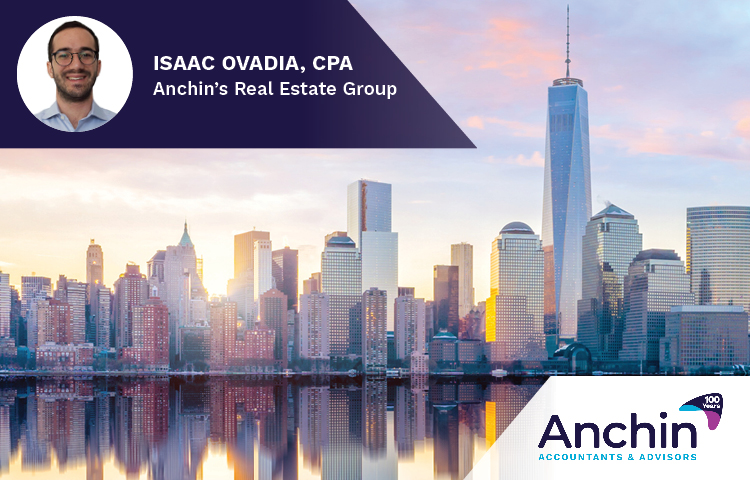Presented By: Anchin
Navigating Change: The NYS Budget’s Impact on the Real Estate Industry
By Isaac Ovadia, CPA at Anchin

While the recently passed 2024-2025 New York State budget addresses a broad spectrum of crucial matters such as health care, public safety, artificial intelligence and education, it also introduces fresh legislation targeting housing-related concerns impacting landlords, tenants and developers. Since the expiration of the 421a program in 2022, the real estate industry has pressed lawmakers for new incentives to further the growth of the changing market landscape. The latest budget introduces three of the newly developed programs designed to aid the real estate industry with navigating the current challenges of today.
Affordable neighborhoods for New Yorkers
The new budget introduces Section 485-x, known as the “Affordable Neighborhoods for New Yorkers” program, which acts as a replacement for the expired 421a incentive program. This new program will exempt the construction of qualified multifamily dwellings from real property taxes in cities with populations of 1 million or more (e.g., New York City). Construction must have commenced after June 15, 2022, but no later than June 15, 2034, and construction must be completed by June 15, 2038.
Some qualifications include meeting certain construction wage standards and leaving income-restricted units as permanently affordable. The size of the construction project will affect: (1) how many units need to be set aside as affordable and (2) the duration of the tax abatements, which range from 10 to 40 years.
Additional requirements include retaining original payroll records and notifying the comptroller three months in advance of starting construction if the building will have more than 100 units. Failure to provide this notice can subject the developer to fines and penalties up to $5,000 a day as well as a forfeit of the tax abatements and exemptions provided under the new program.
However, if one signs a Project Labor Agreement (PLA) or agrees to 100 percent use of union labor, developers may bypass the reporting requirements and wage requirements.
Note, for projects already enrolled in the 421a incentive program prior to its expiration, the budget extends the program for an additional six years. Consequently, developers who broke ground before June 15, 2022, have until June 15, 2031, to complete construction.
Affordable housing from commercial conversions
The budget also introduces the “Affordable Housing from Commercial Conversions” program, which eases regulations and provides tax incentives to convert unused office space into affordable housing. Such property tax reductions could last up to 35 years, depending on when one files and receives the permit.
To qualify, work on the conversion must commence between Jan. 1, 2023, and June 30, 2031, and must be completed no later than Dec. 31, 2039. At least 25 percent of the new apartments must be affordable at a weighted average of the area median income (AMI), including 5 percent at 40 percent of the AMI. All affordable units must remain permanently affordable and permanently rent stabilized.
If the property is in an area of Manhattan south of 96th street, the tax incentive will provide a 90 percent discount off the effective residential rate. In all other areas, the tax incentive will provide a 65 percent discount. The tax break phases out in its final five years.
Good cause eviction law
The “Good Cause Eviction Law” was enacted to limit the ability of a landlord to evict a tenant from a residential unit. Now in order to evict a tenant, the landlord must have “good cause” to do so, which includes, but is not limited to, nonpayment of rent; nuisance; substantial damage, whether malicious or grossly negligent, to the premises or building; illegal use of the premises; or demolition. However, the law requires a landlord to obtain a court order to remove a tenant upon a showing of “good cause.” This policy automatically applies in New York City, whereas other localities may choose to opt in.
There are several exemptions to the “good cause” rule, including:
-
- • Buildings constructed in 2009 or later are exempt for 30 years from the time of completion.
- • Apartments with a monthly rent greater than 245 percent of the fair market rent.
- • Units owned by small landlords who own 10 or fewer units within New York state.
- • Owner-occupied buildings that contain 10 or fewer units.
The new provision enables tenants to challenge evictions resulting from rent increases greater than 10 percent of the existing rent or 5 percent greater than the Consumer Price Index, whichever is lower.
While the 2024-2025 New York State budget demonstrates a comprehensive approach to addressing pressing societal issues, its inclusion of targeted legislation signifies a recognition of the importance of tackling the housing crisis affecting landlords, tenants and developers alike. As these initiatives unfold, it remains crucial for stakeholders to collaborate and adapt to ensure the effective execution and long-term success of these measures.



